Climate-smart practices to mitigate tobacco yield losses in a drought year
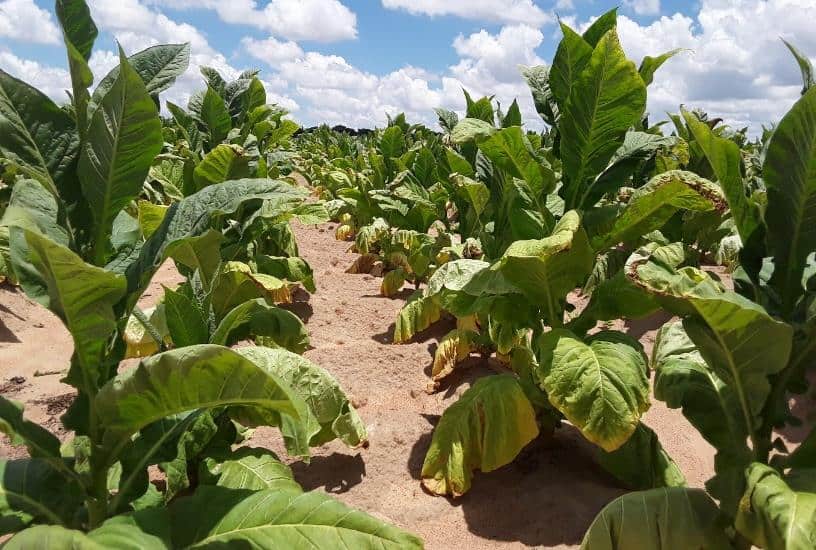
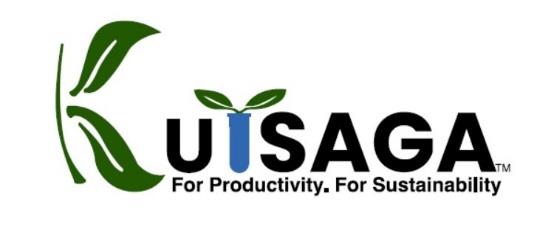
By Dr S. Dimbi and Dr F. Magama
The current weather forecasts indicate a transition into an El Niño state in the second half of 2023 and Zimbabwe is among the countries at risk of dry conditions. Considering the significant impact that water stress has on agricultural production, this article is aimed at highlighting cultural practices tobacco growers can implement to mitigate the devastating effects of the anticipated dry weather conditions.

In a normal season, transplanting of the dryland tobacco crop commences in early October. When adequate water is applied in the planting hole, this allows the crop to survive until the arrival of the rains, four to five weeks later. The plant’s major growth period then commences after the rains. However, in a drought year the dry period is prolonged and the start of the major growth period that is normally triggered by good rains, will be delayed. It is important to ensure that the crop survives the extended dry period and cultural practices can markedly affect the quality of the crop.
The following areas should be looked out for;
1. Land preparation
It is imperative that land preparation be done well (deep ploughing) and early (soon after the rains where possible) to conserve moisture in the soil. The land should then be kept free of weeds. When using animal drought power, ensure deep ploughing, up to 25 cm while with a tractor drawn plough, aim for a depth of up to 40-45 cm. Land preparation is also important in removing weeds that will deplete soil residual moisture that is needed for good establishment of the transplanted seedlings.
2. Quality Seed
An essential starting point for climate-smart crop production is the careful selection and use of quality seed of well-adapted varieties. Growers must therefore, ensure that they source authentic seed of approved varieties from reputable sources, such as Kutsaga.
3. Cultivar Selection
3.1 Drought tolerant varieties
Tobacco is naturally a hardy crop but the propensity and frequent occurrence of drought periods resulted in the development of novel genetics capable of tolerating severe drought conditions. Two varieties; KRK71 and K RK75 have a remarkable capacity to rebound and give high yields and maintain leaf quality after a debilitating drought growing season compared to others. The varieties KRK71 and K RK75 should be the varieties of choice in drought prone areas and also when drought is forecasted.
3.2 High Leaf Potential Varieties
It is recommended that in a drought year, growers select high leaf potential, slow maturing cultivars, that can withstand drought stress without bolting prematurely (before attaining 18/19 leaves). Cultivars with a low leaf potential such as K RK26R, K RK22 and K RK23 may flower early when exposed to a prolonged period of drought stress. However, when the slow maturing varieties are used, this calls for early planting, with planting hole water, and not wait for the rains as they yield well when given a long season.
3.3 Drought Escape
Alternatively, drought escape can be used as a strategy in a drought year. In the 2023/24 season, Kutsaga placed on limited release new climate proofed tobacco hybrids bred for cultivation in marginal areas. These new varieties (T78, T79, T80, and T81) were bred for a generally short growth duration that allows them to mature early and escape drought especially in situations where the crop is predicted to suffer a late-season drought stress. Early maturity also enables the reduction of total seasonal evapotranspiration because of the crop’s short duration in the field.
4. Quality Planting Material
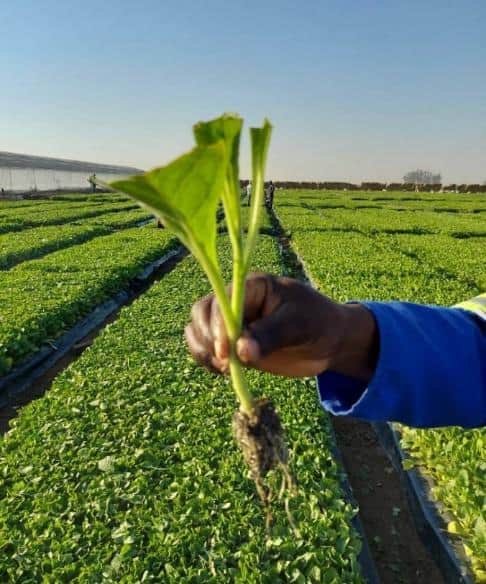
Use disease and pest free seedlings that are uniform and healthy. For seedlings produced using the conventional system, an ideal seedling should have a stem 15-17 cm long and 6-10 mm thick. It must be well-hardened, have 8-10 leaves and must have a strong, vigorous root system. Float seedlings are generally smaller with a stem length of 10-12 cm and about 6-8 mm diameter; however, these survive better in the field because they have an intact root system that minimizes transplant shock. To get the ideal seedling, plan to sow your seedbeds 90 days before the intended planting date.
A well hardened seedling is paler and must pass the finger rolling test. If seedlings are not ready the best option is to delay planting until the seedlings are well hardened as the use of poor-quality seedlings in very hot, dry conditions is a recipe for disaster.
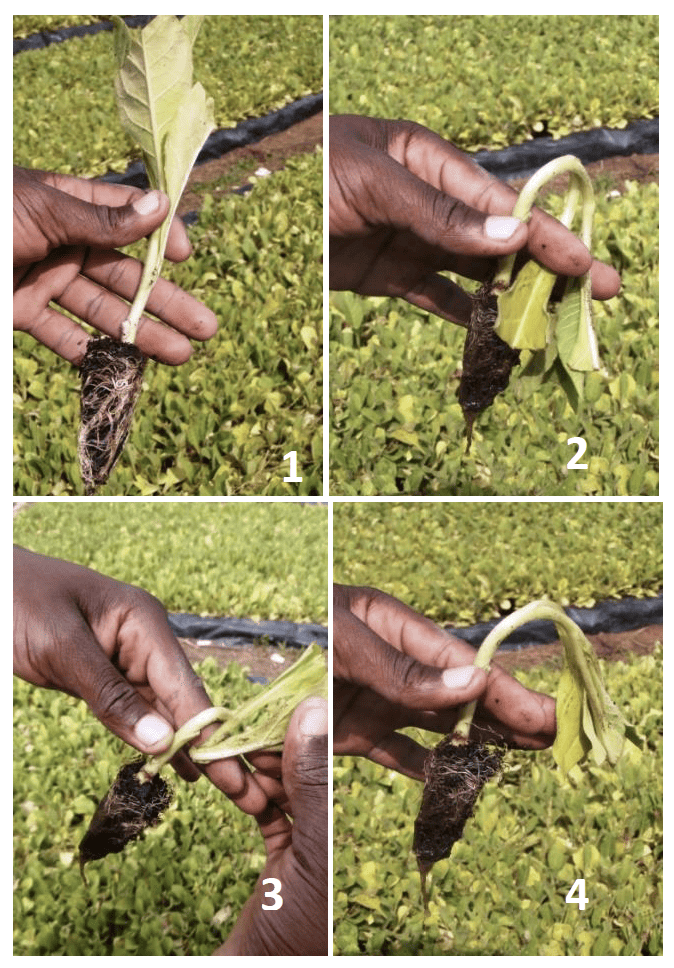
seedling is well hardened
5. Beds rather than ridges
Beds have the advantage that the total surface area exposed to evaporation is less that when single ridges are used. Tie-ridging or potholing should be carried out to enable any rain or added water to be retained and not lost through run-off. Avoid re-ridging during the drought period as this causes moisture to be lost from the soil.
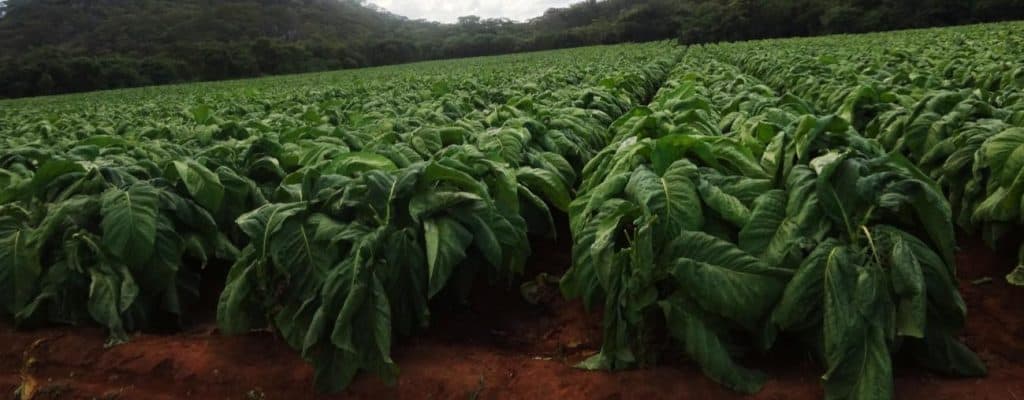
6. Adequate Planting Water
It is important to ensure that sufficient water is applied at planting to link up with residual moisture that had been conserved by early ploughing.
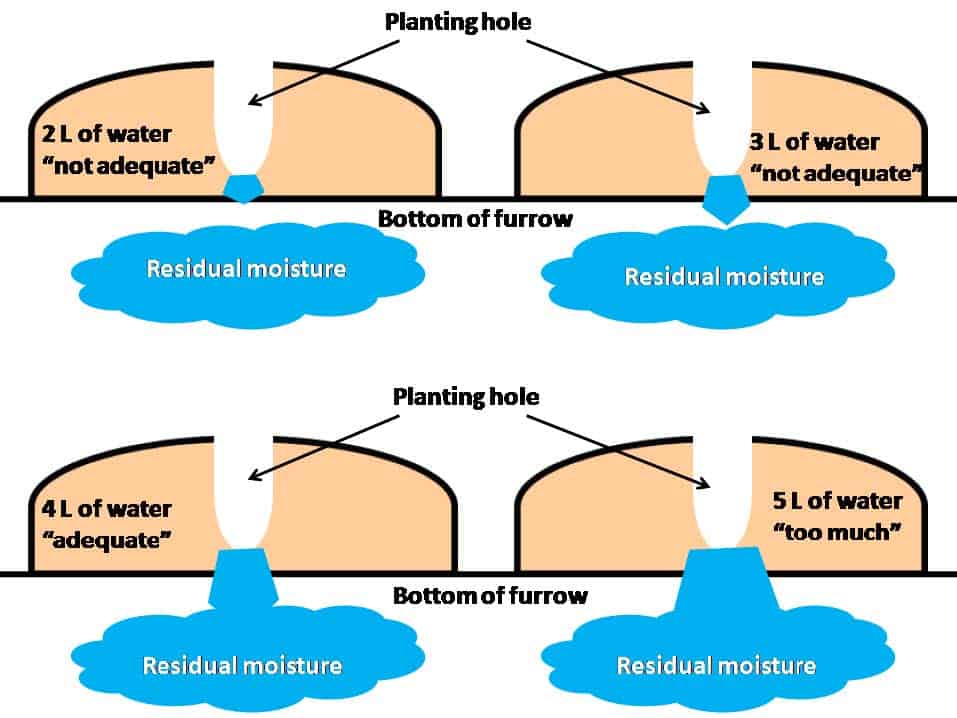
In a season when the rains have been delayed, establishment and survival can be improved by the application of additional water in potholes made between plants on the bed or ridge, after planting. It is also recommended that this be done within two weeks of planting. This is because less water is applied after pre-watering as the soil in the planting hole is already at field capacity. Research at Kutsaga has shown that once the seedlings have taken off and have adequate moisture, they will survive for up to six weeks of dry weather without significant yield losses.
7. Proper Planting Techniques
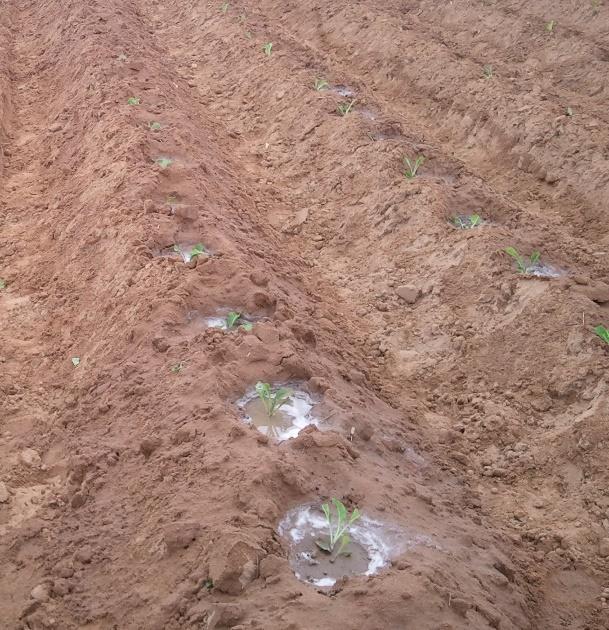
Ensure that seedlings are planted in the centre of the planting hole, straight down and not layered in the soil. This will ensure that the roots are placed in a zone of soil that will not dry out completely, even when rain is delayed for seven to eight weeks.
8. Delay the nitrogen top dressing
In a period when the dry conditions have been prolonged, growers must think very carefully before applying a top-dressing fertilizer to their crop. No Nitrogen either applied (through the basal) or residual will have been lost through leaching and will thus still be in the soil. It is therefore unlikely that the crop will benefit from topdressing and in most cases it will be harmful. When the rains eventually fall, the plants will make maximum use of soil nitrogen. In fact, the hotter and drier the conditions before the start of the rains, the greater the release of mineralized nitrogen The uptake of this Nitrogen will be enhanced by the fact that during the dry period, roots would have continued to grow downwards into subsoil moisture, and good root systems would have developed. However, soil mineralized nitrogen availability is higher in early ploughed lands.
9. Good Weed Control
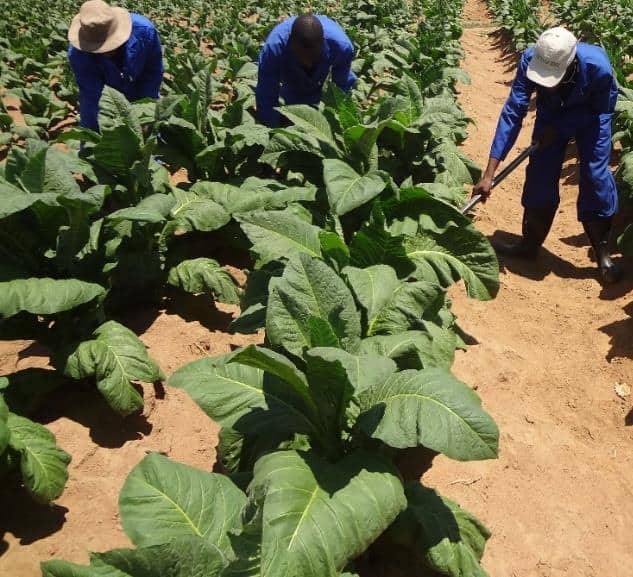
It is essential to remove weeds early and keep crops weed-free during their period of major growth in order to reduce evapotranspiration. Weeds can be managed by herbicide use or manually. If manual weeding is to be done, this must be through light scraping using a swan-neck hoe rather than by deep cultivation with a ‘badza’ as this exposes moist soil to the atmosphere and cause loss of soil moisture.
10. Early topping and good sucker control
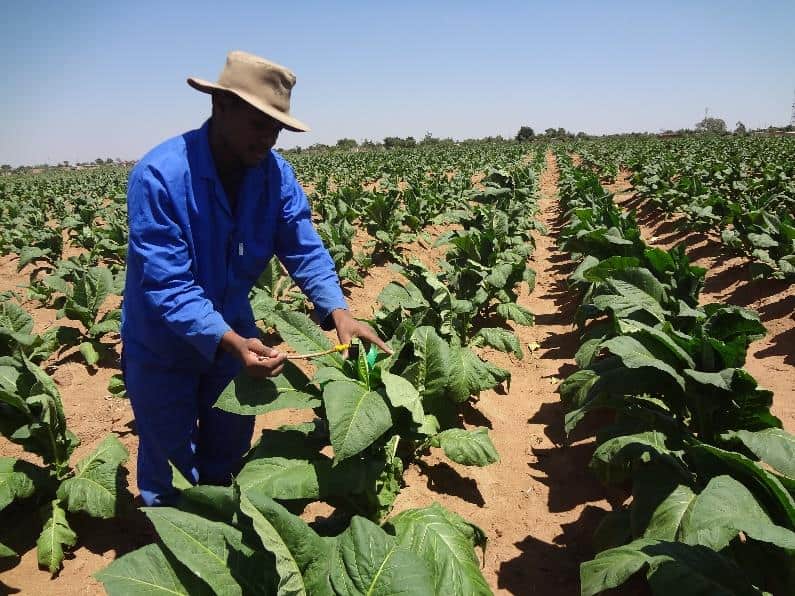
Plants must be topped as soon as possible, although during drought conditions the topping activity has to be carried out over an extended period as plants come into extended bud unevenly. Each plant must be topped as soon as possible after attaining the required leaf number, and this is called bud-topping. In a situation where the crop begins to grow and then becomes very water-stressed a grower must consider topping a little higher than normal to compensate for the scorched lower leaves.
Additionally, good sucker control is recommended as this reduces moisture consumption.
11. Preventative Pest and Disease Management
It is a well-known fact that healthy, actively growing plants have better capacity to withstand pest infestations and disease infections than their stressed counterparts. When it is anticipated that pest and disease pressure will be high (late planting, drought stress conditions) it is important to put in place preventive measures for the management of pests and diseases. Insecticides such as imidacloprid or thiamethoxam applied in the planting hole will ensure that the crop is protected against aphid infestations. These insecticides are also effective against a wide array of soil pests such as white grubs and wire worms that if left uncontrolled will damage plant roots, further weakening the plants.
Other insecticides such as lambda-cyhalothrin and other pyrethroids for cutworm prevention must be applied around the base of each transplant immediately after transplanting, to protect against stand loss.
12. Regular Crop Monitoring
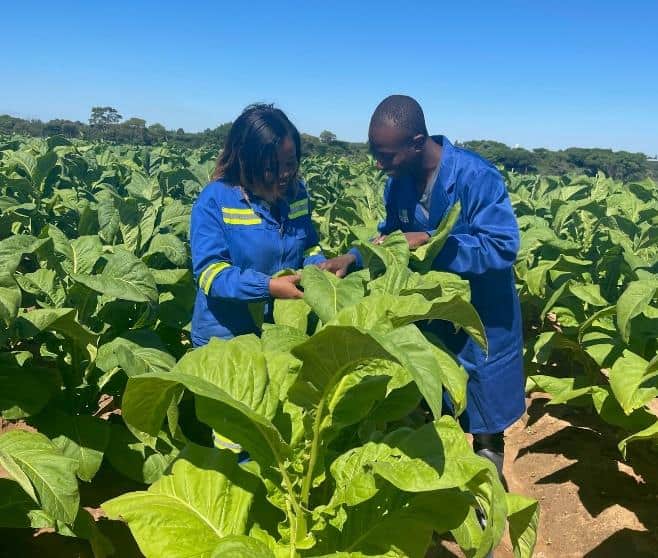
In addition to direct damage (leaf scalding), a significant secondary effect of drought is that it weakens plants and predisposes them to secondary invaders and opportunistic pests. For example, although not usually economically important on tobacco, incidences of red spider mite and scale insect infestations have been widely reported on droughted tobacco crops. It is therefore important for the grower to monitor or scout frequently and systematically for infestation by pests and apply treatments as necessary.
13. Reaping and Curing
Tobacco crops exposed to severe droughts generally ripen very slowly as the less than ideal climatic conditions slow down growth and cause thickening of the leaves. These crops have high starch concentration in the leaves and relatively slow breakdown of the starch. Slow ripening crops which have been under fertilized at some stage in their growth are more prone to produce off-type tobacco (close-grained, thick, harsh natured often with a grey, slatey appearance) if the leaf from such crops is reaped before it is fully ripe and cured too fast.
13.1 Timely Reaping and Controlled Colouring
To achieve the best possible quality, the maximum possible time for starch breakdown must be allowed. This is achieved by reaping the crop ripe ensuring that reaped tobacco is removed from the field and loaded into the barn as quickly as possible to avoid the leaf from being scalded by the sun. During fire start-up, growers must avoid flash temperatures that can dry the leaf before colouring is completed as this sets an undesirable green color. It is important to keep the temperature at less than 330C for the first two days from the day of starting up the fire.
During this period, relative humidity must be kept within 85-90%. This can only be achieved through suppressed ventilation (closed air supply vents) and recirculation of exhaust air in the barn depending on the barn design. It is also important to note that by the end of the colouring process, efficient curing systems must have removed at least 25% of the moisture. Failure to remove sufficient moisture during the colouring process may result in sweating of the tobacco. Therefore, controlled ventilation is supposed to commence once 75% of the leaf has coloured. Growers must make use of the dry and wet bulb thermometers or digital hygrometers to monitor relative humidity.
13.2 Managing Humidity
Humidity control can extend or shorten the coloring time and thus enable the grower to get the most desirable color. The general guide is that the closer the dry bulb temperature reading is to the wet bulb one, the higher the humidity in the barn. If the tobacco is drying too quickly then temperature must be reduced and the vents closed. Opening the vents will speed up leaf drying. If the humidity is lower than required, moisture can be applied through placing wet hessian sacks or pouring water on the barn floor. When the colouring phase is almost complete, the tobacco should have a good yellow color at the leaf tip with slight green-tinged colours running along the main stem and veins to the butt. Once the colouring phase is completed, temperature should be increased moderately at a rate of 30C every four hours.
It is important to note that the curing process approach is unique for each harvest and after reaping, measures have to be taken to achieve the best leaf colour and quality based on the leaf moisture content, maturity and thickness.
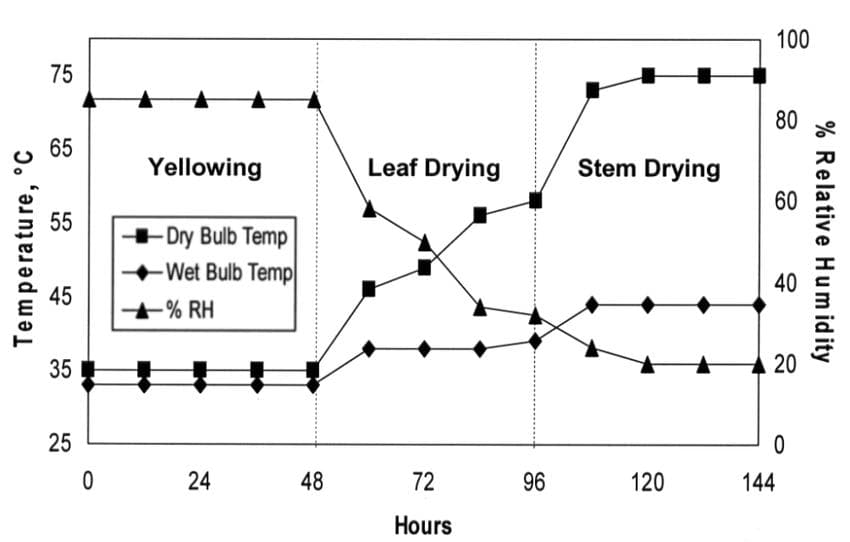
Conclusion
Growers can greatly improve the quality of their crop in a drought season by following these cultural practices aimed at ensuring that transplants establish and survive the adverse conditions. The devil is in the detail! For more information, do not hesitate to contact us on # 086 8800 2604, visit us at Kutsaga Research Station (Airport Ring Road) or get in touch with us on any of our social media handles;
Email: kutsaga@kutsaga.co.zw
X / Twitter: @KutsagaResearch
Facebook: Kutsaga Research
YouTube: Kutsaga Research
Website: https://www.kutsaga.co.zw/
